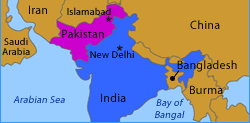Start date: 2003
Proposed length: Approximately 1,800 miles
Official purpose: Prevention of infiltration
Pakistan and India achieved independence from the United Kingdom in the 1947 partition of the Indian subcontinent, and have since fought two wars (1947-48 and 1965) over the still-disputed region of Kashmir. Yet the barrier India is now building has its roots in conflict not with Muslims in Kashmir, but with Sikhs in the Indian state of Punjab. In the late 1980s, Sikh separatists in Punjab bolstered their uprising with weapons smuggled from Pakistani Punjab. (Punjab straddles the Indian-Pakistani border.) In 1989, India began construction of a barrier across the border.
With Sikhs composing about two thirds of Indian Punjab’s population, Punjab is one of the few Indian states without a Hindu majority. Another such state is Jammu and Kashmir, the only Muslim-majority state in India. While Pakistan may have provided material support to Punjabi Sikhs within India, Kashmir has always been a direct conflict between India and Pakistan. In 2002, cross-border conflict, including troop buildups and deaths on both sides of the border, raised tensions to such an extent that the world braced itself for the first-ever war between nuclear powers. A year later, Indian officials began building a barbed-wire fence across the 1972 cease-fire line, known as the Line of Control.
Pakistan has objected to the barrier, arguing that the border is only temporary; India’s actions, Pakistan argues, create de facto “facts on the ground” in a disputed region whose final borders have yet to be determined. India has countered that it has every right to build on its own side of the border, and points to security concerns: where the barrier has been built, infiltration has dropped.
Eventually, India says, fences will cross the entire 1,800-mile border with Pakistan. The barrier has approximately 1,000 miles to go.
- Previous: North Korea/South Korea
- Next: Saudi Arabia/Yemen



